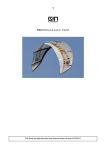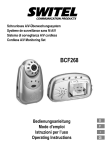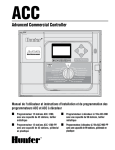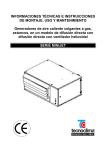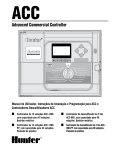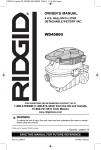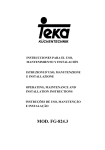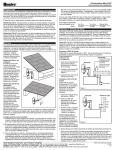Download Hunter ICR User's Manual
Transcript
ICR Institutional Commercial Remote For Use with Hunter Controllers Owner’s Manual and Installation Instructions ® ENGLISH/ESPAÑOL OFF ® MODE ON icr Table of contents...................................................................................... Introduction................................................................................................................................................................... 1 ICR Components............................................................................................................................................................ 2 SmartPort ® Wiring Harness.. ........................................................................................................................................... 4 Installing the SmartPort ® Wiring Harness........................................................................................................................ 4 Wiring the SmartPort ® to Hunter Controllers................................................................................................................... 5 Typical Installations.. ...................................................................................................................................................... 6 Preparing the Transmitter for Use................................................................................................................................... 6 Installing the Transmitter Battery.................................................................................................................................... 7 Changing the Run Time.. ................................................................................................................................................. 7 Changing the Transmitter Address.. ................................................................................................................................. 8 Changing the Maximum Station Number.......................................................................................................................... 8 Preparing the Receiver for Use.. ...................................................................................................................................... 9 Changing the Receiver Address....................................................................................................................................... 9 Activating a Station with the ICR................................................................................................................................... 10 Maximizing Operating Range.. ....................................................................................................................................... 11 Troubleshooting Guide.. ................................................................................................................................................ 12 Specifications.. ............................................................................................................................................................. 13 TABLa de contenido.................................................................................... Presentación del Producto............................................................................................................................................ 15 Componentes del ICR................................................................................................................................................... 16 Conexión de Cableado del Programador SmartPort ®. ..................................................................................................... 18 Instalación del Arnés de Cableado SmartPort.. ............................................................................................................... 18 Conexión de Cableado del Programador SmartPort ®. ...................................................................................................... 19 Instalaciones Típicas.................................................................................................................................................... 20 Preparación del Emisor Antes de su Uso....................................................................................................................... 20 Colocación de la Pila del Emisor.. .................................................................................................................................. 21 Cambio del Tiempo del Ciclo de Riego.. ......................................................................................................................... 21 Modificación de la Dirección del Emisor........................................................................................................................ 22 Modificación del Número Máximo de Estaciones.. .......................................................................................................... 22 Preparación del Receptor Antes de su Uso.. .................................................................................................................. 23 Modificación de la Dirección del Receptor..................................................................................................................... 23 Activación de una Estación por Medio del Sistema de Mando a Distancia ICR................................................................. 24 Optimización de la Zona de Funcionamiento.. ................................................................................................................. 25 Guía Para Solucionar Problemas................................................................................................................................... 26 Datos Técnicos............................................................................................................................................................. 27 Introduction................................................................................................ Finally there’s an affordable remote control system designed with the commercial irrigation contractor in mind. Hunter is pleased to introduce the Institutional Commercial Remote (ICR). This rugged remote design offers similar functionality as our SRR remote, but with longer range capability. With the ICR there’s no need to walk back and forth to the controller to conduct manual watering operations when doing maintenance or repair work on your irrigation systems. Also, winterization can be done quickly and easily with one worker instead of two. The ICR is designed to be rugged, and water resistant. Its large LCD display and push button design makes it easy to operate. Best of all, with an operating range from ½ to 1 mile, you’ll be able to conduct remote operations on even the largest irrigation systems. The following instructions provide information on installing, setting up, and operating your ICR. ICR Components.............................................................................................. B A D C 9 4 ® 6 2 8 OFF 1 MODE ON ICR 3 5 7 This section will provide a brief overview of some of the components on the ICR. Each item will be discussed in further detail later, however, this section can be helpful in getting acquainted with the different options available. A – Transmitter 1. Transmitter Body – The ICR transmitter is designed to be dirt tolerant and water resistant. B – Receiver 7. Receiver Body – Rugged, water resistant design. 8. Addressing Button – Allows for easy receiver to . transmitter addressing. 9. External Antennae – Flexible, removable antennae . for maximum range. 2. LCD Display – Large, easy to read LCD display. C – SmartPort® 3. Control Buttons – Push button operation. D – Carrying Case 4. External Antennae – Flexible, removable rubber for maximum radio range. 5. Battery Compartment – The ICR is designed to operate on a four AA alkaline batteries. The batteries easily drop into a battery holder. 6. Belt Clip – Belt clip provides convenient access to the transmitter at all times. SmartPort® Wiring Harness........................................................................ To utilize the ICR remote control system, your controller must be equipped with a SmartPort wiring harness. This wiring harness provides the communication port where the ICR receiver is attached. The SmartPort can be connected to Hunter SRC, Pro-C and ICC controllers. A SmartPort wiring harness is provided with your ICR remote system. The typical SmartPort location is approximately 12" below the controller. The recommended installation procedure for this location would be as follows: To Controller 1/2" Thread Pre-assembled Assembled Installing the SmartPort Wiring Harness......................................... 1. Install a ½" female threaded “Tee” in the field wiring conduit approximately 12" below the controller. NOTE: The harness may be installed outdoors by bringing the conduit through an exterior wall, then installing the appropriate fitting. 2. Feed the red, white, and blue wires of the SmartPort through the base of the “Tee” and into the controller wiring compartment as shown in the following figures.. NOTE: For installations where the receiver will be installed permanently on an outside wall, make certain that the SmartPort is the version with an o-ring seal. wiring the SmartPort® to hunter controllers............................... SRC Controller SmartPort Installation ICC Controller SmartPort Installation Access the terminal strip area and attach the red wire to the left AC screw slot, attach the white wire to the next AC screw slot and attach the blue wire to the screw slot marked “R”. Access the terminal strip area on the power module and attach the red wire to the bottom most AC screw slot, attach the white wire to the upper AC screw slot and attach the blue wire to the screw slot marked “REM”. AC AC R RS C MV 1 2 3 4 5 6 Blue Red White Pro-C Controller SmartPort Installation Access the terminal strip area on the main module and attach the red wire to the bottom most AC screw slot, attach the white wire to the upper AC screw slot and attach the blue wire to the screw slot marked “REM”. Blue White Red NOTE: Hunter ACC controllers are provided with the SmartPort ® Factory installed. Blue White Red Typical Installations................................................................................. Although the ICR Receiver is water resistant, it is recommended that the SmartPort ® connector and Receiver be mounted indoors if it is to be left permanently mounted to the controller. Indoor Installation Outdoor Installation (Temporary Connection of Receiver Only) Controller Receiver Preparing the Transmitter for Use.................................................. The ICR remote system is designed to work right out of the box. This means that other than installing the battery, you may choose to skip this entire section. However, we recommend that you read it so that you can customize your ICR to add functionality and security to your system. Installing the Transmitter Batteries............................................. The ICR transmitter requires 4 AA alkaline batteries. To install the batteries. remove the two screws holding the battery on the back of the transmitter. Drop the batteries into the battery compartment and replace the door. Your transmitter is now ready to operate. Changing the Run Time............................................................................... You have the ability to adjust the amount of time that a station will run once it has been turned on by your ICR. This does not affect the run time programmed into your controller. This adjustment is made at the transmitter as described below. To change the Run Time: 1. If the unit is OFF (no display), power the transmitter by pressing any of the buttons for at least 1 second then releasing the button. The transmitter will illuminate and display the active station. 2. Press the Mode button until the words “Run Time” along with the current Run Time is displayed. (default is 10 minutes) The Run Time will be blinking at this point. If more than 5 seconds go by without a button being pressed, the Transmitter will revert back to displaying the active station. 3. Use the or buttons to 36/5*.& change the Run Time to any of the 8 settings ranging from 1 to 90 minutes. Then do not touch any of the buttons for 5 seconds and the display will stop blinking and return back to the active station. Changing the Transmitter Address................................................... Both the ICR Transmitter and Receiver have an “address” that they use when communicating. If the addresses do not match, the Receiver will ignore the transmission. Your ICR comes from the factory with both the transmitter and Receiver address set to 0. You may change the address to any value from 0-127 for added security. Note that if you change the Transmitter address, the Receiver must “learn” the new address as described in the “Preparing the Receiver for Use” section. To change the Transmitter address: 1. If the unit is OFF (no display), power the Transmitter up by pressing any of the buttons for at least 1 second then releasing the button. The Transmitter will illuminate the active station. 2. Press the Mode button until the word “Address” appears on the display. The address will be blinking at this point. If more than 5 seconds go by without a button being pressed, the Transmitter will revert back to displaying the active station. 3. Use the or button to change the address to any value "%%3&44 between 0 and 127. Then do not touch any of the buttons for 5 seconds and the display will stop blinking and return back to the active station. Changing the Maximum Number of Stations.................................. Your ICR Transmitter comes from the factory with the maximum number of stations set to 9. This means that when you use the or buttons to change the station, you may change it to any number between 1 and 9. However, if you have controllers with more than 9 stations you will want to increase the maximum number of stations. To change the Maximum Number of Stations: 1. If the unit is OFF (no display), power the Transmitter up by pressing any of the buttons for at least 1 second then releasing the button. The Transmitter will illuminate the active station. 2. Press the Mode button until the word “Max Station” appears on the display. The maximum number of stations will be . blinking at this point. provides the user with the ability to operate programs . (A, B, C). ACC/ACC Decoder Controllers ."945"5*0/ 3. Use the or button to increase or decrease the maximum number of stations. Then do not touch any of the buttons for 5 seconds and the display will stop blinking and return back to the active station. The ICR is designed to operate with two groups of Hunter controllers: SRC/Pro-C/ICC Controllers The maximum number of stations from 1 to 48. The ICR also Selecting the maximum station number 240 allows the user to operate up to 240 stations and 18 programs (programs are displayed with a P and program number ex: P5). NOTE: When the ICR transmitter is set in the ACC mode (240 stations), the ICR will only communicate with ACC controllers. To operate other Hunter controllers (SRC, Pro-C, and ICC) with your remote, the transmitter max stations needs to be set to a number from 1 to 48 stations. Preparing the Receiver for Use............................................................. As stated earlier, your ICR is designed to work right out of the box. If you have decided to change your Transmitter address as described in the previous section, you must allow the Receiver to “learn” this new address. Once learned, the only way to remove the address from the Receiver memory is to learn a different address. This can be done by following the simple steps outlined below. Changing the Receiver Address 1. Hold down the single button on the face of the Receiver while you are plugging it into an active SmartPort ® wiring harness (one connected to a powered controller). When this is done the . Receiver will beep 4 times. 2. After the Receiver starts to beep, release the button. 3. Press either the “ON” or “OFF” button on your transmitter. 4. The Receiver will beep 4 additional times indicating that it has learned the new Transmitter address and will respond only to it from this point on. The ICR system will allow you to remotely turn on and off any station on your Hunter controller with the press of a button. Once on, the station will run for the run time you have designated in the ICR transmitter. Activating a Station with the ICR Remote System....................... To remotely activate a station or program: 1. Plug your Receiver into an active SmartPort wiring harness (one attached to a powered controller) and wait for 2 beeps indicating the Receiver is ready. ® 2. If your Transmitter is not on (no display), press any button for at least 1 second and release. The Transmitter will display the active station. 3. Use the or buttons to display the station or program (A,B, or C) you would like to start. 10 4. Momentarily press the “ON” button to start the station or program. The Transmitter will display the word “TRANSMIT” 45"5*0/ and will flash for about 4 seconds indicating that it is sending the command to the Receiver. If you are near the Receiver, you will hear it beep 2 times, indicating that it has received the command. 5. Press the “OFF” button at any time to turn off the station or program. The display will again read “TRANSMIT” and flash, and the Receiver will again beep twice. The ICR is designed to turn one station on at a time. Therefore, turning a station on while another is already on will cause the first station to turn off. 6. If one of the programs (A,B, C or P1 through P18) is selected, all stations in the selected program will run sequentially for the run time programmed in the controller. NOTE: The ICR remote can activate any station on the controller whether the controller dial is in the “System Off”, “Run” or “Run/Bypass Sensor” modes. If a sensor device has been wired to the controller, the ICR will not override the sensor for manual operation. Maximizing Operating Range.................................................................. The ICR is designed as an extended range remote that should meet the range requirements for even the largest irrigation systems. The maximum range of transmission will vary from approximately ½ mile to 2 miles depending upon the site terrain and the location of the Receiver. Listed below are a few steps to assure that you are getting the maximum range possible: 1. Do not install the SmartPort ® wiring harness (that the Receiver connects to) near large sources of metal such as power meters, water pipes, and metal siding. 3. For maximum range in all directions from the Receiver, the Receiver antennae should be pointed straight up (vertically). If the Receiver is mounted with its antennae oriented horizontally, reception will be very good if the Transmitter is on either side of the antennae, but poor if it is facing the end of the antennae. 4. When operating the Transmitter, hold the Transmitter as vertical as possible and turn and face the direction of the Receiver even though it may be a long way away. 2. Do not install the SmartPort wiring harness in a basement or underground location. 11 Troubleshooting Guide.............................................................................. PROBLEM CAUSes Solutions Transmitter is blank. Transmitter is Off.. . Battery is dead. Press any button for 1 second.. . Replace battery. Can’t access all the desired stations on the transmitter. Maximum station number is . set wrong. See “Setting the Maximum Station stations Number” SmartPort is not connected properly.. Recheck the SmartPort installation.. Receiver doesn’t beep two times . after plugging it into the SmartPort®. . Controller has no power. Check controller power. 12 Receiver beeps twice after plugging it in, but won’t respond to the transmitter. Receiver and Transmitter addresses don’t match. Relearn address at Receiver. Transmitter display stays on. Transmitter will turn off automatically. Wait approximately 2 minutes without pressing any buttons. Transmitter will “fall asleep.” Specifications................................................................................................. Operating Specifications Dimensions • Transmitter (w/o antennae): Height: 6.5". Width: 3.25". Depth: 1.25" Address Range: 0-127 • Maximum stations supported: 240 • Run Time: 8 settings from 1 to 30 minutes • Range: up to 2 miles depending upon time terrain Electrical Specifications • Power Source Transmitter: 4 AA alkaline batteries • Power Source Receiver: 24VAC, 0.050 amps • System Operating Frequency: 27MHz band Receiver (w/o antennae): Height: 6.25". Width: 3". Depth: 1.25" Default Settings Address = 0 (may be varied from 0-127) Number of Stations = 9 (may be varied from 1-48) Run Time: 10 minutes 13 Presentación del Producto..................................................................... Por fin hay un sistema de mando a distancia fiable y accesible, diseñado teniendo en mente las necesidades del contratista de la industria de riego comercial. La sociedad Hunter está satisfecha del lanzamiento del ICR, un sistema de mando a distancia. Su diseño de alta resistencia le permite funcionabilidad similar al sistema de mando tipo SRR, pero con una capacidad de mayor distancia. Con el ICR no existe la necesidad de caminar de ida y regreso al programador para llevar a cabo operaciones de riego cuando esté haciendo labores de mantenimiento o reparación de su sistema de riego. Asimismo, las actividades de preparación para el invierno pueden implementarse rápida y fácilmente con un trabajador en lugar de dos. El ICR está diseñado para ser de alta dureza e impermeable. Su gran pantalla LCD y su diseño de teclas de presión lo hacen fácil de operar. Lo mejor de todo es que, con un rango de operación de ½ hasta 2 millas, dependiendo del terreno, usted podrá ejecutar operación con control de mando, aún en los sistemas de riego más extensos. Las siguientes indicaciones le proporcionarán la información necesaria para instalar, modificar y operar su sistema . operativo ICR. 15 Componentes del ICR................................................................................... B A D C 9 4 ® 6 2 8 OFF 1 16 MODE ON ICR 3 5 7 Esta sección le proporcionará un breve resumen ejecutivo respecto a los componentes del ICR. Cada componente será comentado con mayor detalle posteriormente, asimismo, la presente sección le será útil para familiarizarse con las diferentes opciones disponibles del producto. A – Emisor 1. Cuerpo del Emisor – El Emisor ICR está diseñado para soportar la suciedad y es impermeable. B – Receptor 7. Cuerpo del Receptor – De alta resistencia, con diseño impermeable. 8. Botón de Acceso – Le permite un fácil acceso al receptor para comunicarse con el emisor. 9. Antenas Externas – Flexibles, desmontables para un radio de acción óptimo. 2. Pantalla tipo LCD – Grande, fácil de leer C – SmartPort® 3. Tecleado de Mando a Distancia de Presión – Fácil de operar. D – Caja 4. Antenas Externas – Flexibles, de goma desmontable para un radio de acción óptimo. 5. Compartimiento de las Pilas – El diseño ICR es fácil de operar mediante cuatro pilas alcalinas. 6. Porta- Cinturón – Le proporciona, en todo momento, un conveniente acceso al emisor. 17 Conexión de Cableado del Programador SmartPort®.................... A fin de poder utilizar el sistema de mando a distancia ICR, su programador Hunter está equipado con un arnés de cableado SmartPort. Dicho cableado de arnés le proporciona una comunicación al puerto a donde se conecta el receptor ICR. El SmartPort puede conectarse a los programadores SRC, Pro-C y al programador ICC. Para su conveniencia, su sistema de mando a distancia ICR incluye un arnés de cableado tipo SmartPort. La localización típica del SmartPort es de 12" abajo del programador. El procedimiento que se recomienda para la instalación respectiva es como sigue: Al Programador / " Rosca 1 2 Pre-ensamblado Ensamblado Instalación del Arnés de Cableado SmartPort................................. 1. Instale un adaptador de “T” de rosca hembra de ½" en el compartimiento del cableado aproximadamente 12" abajo del programador. NOTA: El arnés puede en el exterior estableciendo un conducto a través de la pared externa, y posteriormente, llevar a cabo la instalación adecuada). 18 2. Pase los cables rojo, blanco y azul del SmartPort por la base de la “T” hacia el compartimiento del cableado como se indica en la ilustración. Conexión de Cableado del Programador SmartPort®.................... Instalación SmartPort del Programador SRC Module Instalación SmartPort delPower Programador ICC Con acceso al compartimiento de cableado, conecte el cable rojo al primer borneo marcado AC, el blanco al borneo . sugundo marcado AC y el azul al borneo R. Con acceso al compartimiento de cableado, conecte el cable rojo al borneo bajo marcado AC, el blanco al borneo superior marcado AC y el azul al borneo REM. AC AC R RS C MV 1 2 3 4 5 6 Azul Rojo Blanco Instalación SmartPort del Programador Pro-C Con acceso al compartimiento de cableado, conecte el cable rojo al borneo bajo marcado AC1, el blanco al borneo superior marcado AC2 y el azul al borneo REM. Azul Azul Blanco Rojo NOTA: Los programadores Hunter ACC están provistos de un SmartPort instalado de fábrica. Blanco Rojo 19 Instalaciones Típicas............................................................................... Aunque el Receptor ICR es impermeable, se recomienda que, el conector SmartPort ® y su Receptor sean montados bajo techo, si es que se va a dejar montado al programador respectivo en forma permanente. Instalación Interior Instalación Exteriór (Conexion Temporal Únicamente del Receptor) Programador Receptor Preparación del Emisor Antes de su Uso....................................... El sistema de mando a distancia ICR está diseñado para funcionar inmediatamente. Ello significa que, exceptuando la colocación de las pilas, se pueden ignorar completamente, las instrucciones que siguen. Recomendamos, sin embargo, se lean para personalizar su ICR y agregar la funcionabilidad y seguridad de su sistema. 20 Colocación de la Pila del Emisor....................................................... Su emisor ICR funciona con cuatro pilas alcalinas de clase AA. Para instalar las pilas, desplace los dos tornillos que sujetan el compartimiento posterior del emisor. Introduzca las pilas en dicho compartimiento e instale nuevamente la tapa posterior. Concluyendo lo anterior, su emisor está listo para operar. Cambio del Tiempo DEL CICLO de Riego............................................... Una vez que el ICR haya sido activado, usted cuenta con la habilidad de ajustar el ciclo de riego que desea en una estación determinada. Lo anterior, no afecta el ciclo de riego que haya programado en su programador. Dicho ajuste se lleva a cabo con el emisor según se indica a continuación. Cambios al Tiempos de Riego 1. Si el emisor no está alimentado OFF (ausencia en pantalla), colocarlo bajo tensión pulsando cualquier tecla durante al menos 1 segundo, entonces, suelte la tecla. El emisor iluminará la pantalla y se activará la estación correspondiente. 2. Presione la tecla “Mode”, hasta que aparezcan las palabras “Run Time”. (La duración de falla es de 10 segundos). A continuación la 36/5*.& pantalla está intermitente. Señalamos que, si se esperan más de 5 segundos sin solicitar ninguna tecla, el emisor visualiza de nuevo la estación activa. 3. Utilizar las teclas y para seleccionar uno de los 8 ajustes de la duración del riego que van de 1 a 90 minutos. No pulsar ninguna tecla durante al menos 5 segundos, la pantalla deja de estar intermitente y vuelve a la indicación de la estación activa. 21 Modificación de la Dirección del Emisor....................................... El emisor y el receptor ICR poseen una “dirección” que utilizan para comunicarse entre sí. Cuando ambas direcciones no corresponden, el receptor ignora la transmisión. A la salida de fábrica, las dos direcciones del sistema de mando a distancia ICR están programadas a 0. Puede dar a la dirección un valor comprendido entre 0 y 127 para aumentar la seguridad del sistema. Señalamos que cuando se modifique la dirección del emisor, el receptor tendrá que “aprender” la nueva dirección, como se especifica en el capítulo “Preparación del Receptor Antes de Utilizarlo”. 2. Presione la tecla “Mode”, hasta que aparezcan las palabras “Run Time”, junto con la duración del ciclo de riego actual. (La duración de falla es de 10 segundos). A continuación la pantalla está intermitente. Señalamos que, si se esperan más de 5 segundos sin solicitar ninguna tecla, el "%%3&44 emisor visualiza de nuevo la estación activa. Para Modificar la Dirección del Emisor 3. Utilizar las teclas y para modificar cualquier dirección comprendida entre los valores 0 al 127. No pulsar ninguna tecla durante al menos 5 segundos, la pantalla deja de estar intermitente y vuelve a la indicación de la estación activa. 1. Si el emisor se encuentra sin alimentación (pantalla apagada), ponerlo bajo tensión pulsando cualquier tecla durante al menos 1 segundo. Toda la pantalla se enciende durante 1 segundo aproximadamente y a continuación aparece el número de la estación activa. Modificación del Número Máximo de Estaciones...................... 22 El emisor ICR está ajustado en fábrica con un número máximo de estaciones igual a 9. Ello significa que se pueden utilizar las teclas y , para cambiar el número de estaciones entre 1 y 9. Sin embargo, si tiene programadores con más de 9 estaciones, se puede incrementar dicho número máximo de estaciones procediendo de la siguientes manera. Para Modificar el Número Máximo de Estaciones 1. Si el emisor se encuentra sin alimentación OFF (pantalla apagada), ponerlo bajo tensión pulsando cualquier tecla durante al menos 1 segundo. El emisor ilumina la estación activa. 2. Presione la tecla “Mode”, hasta que aparezcan las palabras “Max. Station” en la pantalla. A continuación aparece en la ."945"5*0/ pantalla, en forma intermitente, el número máximo de estaciones. Señalamos que, si se esperan más de 5 segundos sin solicitar ninguna tecla, el emisor visualiza de nuevo la estación activa. 3. Utilizar las teclas y para incrementar o reducir, el número máximo de estaciones. Posteriormente, no pulsar ninguna tecla durante al menos 5 segundos, la pantalla deja de estar intermitente y vuelve a la indicación de la estación activa. El ICR está diseñado para que funcione con dos grupos de programadores Hunter: Programadores SRC/Pro-C/ICC El máximo número de estaciones de 1 a 48. El ICR proporciona además la capacidad de poner programas en funcionamiento (A, B, C). Programadores ACC/ACC99D de decodificadores La selección del máximo número de estaciones, 240, permite poner en funcionamiento hasta 240 estaciones y 18 programas (los programas se muestran con una P y el número de programa, ej.: P5). NOTA: Cuando el mando a distancia ICR transmite en modo ACC (para 240 estaciones) sólo podrá comunicarse con modelos de programadores ACC. Para utilizar programadores estánderes de Hunter (SRC, Pro-C y ICC) se deberá utilizar el modo de transmisión estándar (programado para funcionar de 1 a 48 estaciones). Preparación del Receptor Antes de su Uso........................... Como ya hemos señalado, su sistema de mando a distancia ICR, está listo para su empleo. Si ha cambiado la dirección de su emisor del modo anteriormente descrito, el receptor respectivo tiene que “aprender” la nueva dirección. Una vez que el receptor haya aprendido la nueva dirección, la única manera de borrarla consistirá en enseñarle otra actuando de la manera siguiente: 23 Modificación de la Dirección del Receptor 2. Soltar el botón en cuanto se oiga el primer bip. 1. Mantener hundida la única tecla situada sobre la cara delantera del receptor mientras que se conecta a un conjunto de cables bajo tensión de un SmartPort ® (el programador bajo tensión). Cuanto esto sucede, el Receptor emite cuatro bips acústicos. 3. Pulsar la tecla “ON” o la tecla “OFF” de su emisor. 4. El Receptor produce 4 bips acústicos para indicar que ha aprendido la nueva dirección del emisor y que ya no contestará a otra distinta. Activación de una Estación por Medio del Sistema de Mando a Distancia ICR................................................ El sistema de mando a distancia ICR permite arrancar o parar cualquier estación de su programador Hunter presionando una única tecla. Una vez que se ha activado una estación, la misma funcionará durante el ciclo de riego programado por medio del emisor ICR. Para Activar a distancia una estación o un programa, hay que proceder de la manera siguiente: 1. Conectar su Receptor a un SmartPort ® activo (el programador bajo tensión) y espere a que el mismo emita 2 bips acústicos indicando que el Receptor está listo. 2. Si el emisor no está alimentado (sin pantalla), pulsar cualquier 24 45"5*0/ tecla durante al menos 1 segundo y a continuación aparece el número de la estación activa. 3. Utilizar las teclas y para visualizar la estación o el programa (A, B, o C) que desea activar. 4. Pulsar la tecla “ON” para arrancar la estación o programa. Sobre la pantalla del emisor aparecen las palabras “ON” y “TRANSMIT” y están intermitentes durante aproximadamente 4 segundos para indicar que se ha transmitido la orden al receptor. El Receptor emite 2 bis acústicos para indicar que ha recibido la orden. 5. Pulsar la tecla “OFF” en cualquier momento a fin de parar la estación o programa que están funcionando. Aparecen las palabras “OFF” y “TRANSMIT” en forma intermitente, y el Receptor emite de nuevo 2 bips acústicos. El sistema ICR ha sido diseñado para poner una sola estación en marcha cada vez. Por consiguiente, si se pone en marcha una estación cuando ora está ya funcionando, esta última se parará automáticamente. 6. Si uno de los programas (A, B, C o desde el P1 al P18) se selecciona, todas las estaciones en el programa seleccionada arrancan en forma secuencial por el ciclo de riego programado por el programador. NOTA: El sistema de mando a distancia ICR puede activar cualquier estación del programador, poco importa que el selector giratorio se encuentra en posición PARADO, MARCHA, o ARRANQUE / SENSOR DE DESVIACIÓN “System off”, “Run” o “Run/ Bypass Sensor”. Si se ha conectado un captador al programador, el sistema ICR pondrá en desviación dicho captador, para emitir un funcionamiento manual. Optimización de la Zona de Funcionamiento........................................... La funcionabilidad del ICR está diseñada con una extensa capacidad de mando a distancia para satisfacer los requerimientos de sistemas de riego más grandes. La distancia máxima de la zona de funcionamiento varía entre aproximadamente una ½ y hasta 2 millas, dependiendo de las características del terreno y la localización del receptor. A continuación se proporciona una lista de algunas que se pueden adoptar para asegurar una zona de funcionamiento más grande posible: 1. No instale la salida de cables SmartPort ® (a la que está conectada el receptor) cerca de una masa metálica importante, como por ejemplo un contador, una tubería de agua, un revestimiento de aluminio. 2. No instale la salida de cables SmartPort en un sótano o en cualquier otro lugar subterráneo. 3. Para obtener una zona de funcionamiento máxima del Receptor en todas las direcciones, la antena del Receptor tiene que orientarse hacia arriba (posición vertical). Si el Receptor está instalado con posición horizontal, la recepción será muy buena cuando el Emisor está colocado a uno de los lados de la antena, pero será muy mala cuando el Emisor esté enfrente del extremo de la antena. 4. Cuando se utiliza el emisor, hay que mantenerlo lo más vertical posible y hay que girarse hacia el Receptor aunque se encuentre muy alejado. 25 Guía Para Solucionar Problemas.......................................................... 26 Problema Causas Soluciones El Emisor está en blanco. El Transmisor está apagado.. . La pila está descargada. Presione cualquier tecla por 1 segundo.. . Reemplace la pila. No se pueden accesar todas las estaciones deseadas el en Emisor. El número máximo de estaciones es incorrecto. Vea “Modificación del Número Máximo de Estaciones”. El Receptor no emite 2 bips acústicos cuando se conecta al SmartPort®. El SmartPort no está conectado correctamente.. . El programador no tiene corriente eléctrica. Verifique que la instalación del SmartPort . sea correcta.. . Verifique la corriente eléctrica del programador. El Receptor no emite 2 bips acústicos después de conectarlo al SmartPort. Las direcciones entre el emisor y el receptor no coinciden. Re-programe la dirección del receptor. La pantalla del Emisor queda encendida. El emisor se apagará automáticamente. Espere por aproximadamente unos 2 minutos sin presionar ninguna tecla. El emisor “se irá a dormir”. Datos Técnicos................................................................................................ Especificaciones de Operación Dimensiones • Emisor (sin antena): Altura: 16.5 cm. Ancho: 8.26 cm. Profundidad: 3.17 cm Direcciones: 0-127 • Número máximo posible de estaciones: 240 • Tiempos de Riego: 8 reglajes de 1 a 30 minutos • Alcance: hasta 2 millas dependiendo del terreno Especificaciones Eléctricas • Alimentación del emisor: 4 pilas alcalinas AA • Alimentación del receptor: 24VAC, .05 amperes • Frecuencia de funcionamiento del sistema: . una banda de 27 Mhz Emisor (sin antena): Altura: 15.87 cm. Ancho: 7.6 cm. Profundidad: 3.17 cm Reglaje por falla • Dirección = 0 (puede ajustarse entre 0 y 127) • Número de estaciones = 9 (puede ajustare entre 1 a 48) • Tiempos del ciclo de Riego = 10 minutos 27 FCC Compliance Notice................................................................................ This device does not require an FCC License. The ICR Receiver complies with the limits of Part 15 of the FCC Rules. The Transmitter complies with Part 95 Subpart E of the FCC Rules. These limits are designed to provide reasonable protection against harmful interference when this equipment is operated in a commercial environment. Este sistema no requiere de ninguna licencia de la FCC. El receptor ICR cumple con los límites especificados por la Sección 15 de las Reglas correspondientes de la FCC. El emisor cumple con los estándares definidos en la parte 95, sub-parte E de las Reglas de la FCC. Estos límites se han designado para proporcionar una protección razonable contra cualquier interferencia cuando el equipo y el sistema estén funcionando en un medio ambiente comercial. Hunter Industries Incorporated • The Irrigation Innovators 1940 Diamond Street • San Marcos, California 92078 www.HunterIndustries.com • www.HunterRiego.com © 2007 Hunter Industries Incorporated P/N 700914 LIT-357 4/07
This document in other languages
- español: Hunter ICR
































